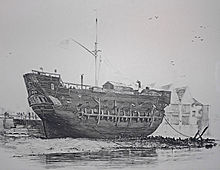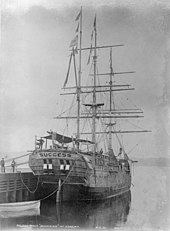
A hulk is a ship that is afloat, but incapable of going to sea. Hulk may be used to describe a ship that has been launched but not completed, an abandoned wreck or shell, or to refer to a ship whose propulsion system is no longer maintained, or has been removed altogether. The word hulk also may be used as a verb: a ship is "hulked" to convert it to a hulk. The verb was also applied to crews of Royal Navy ships in dock, who were sent to the receiving ship for accommodation, or "hulked". Hulks have a variety of uses such as housing, prisons, salvage pontoons, gambling sites, naval training, or cargo storage.
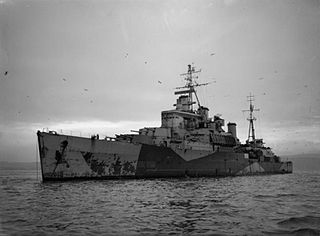
HMS Newfoundland was a Fiji-class light cruiser of the Royal Navy. Named after the Dominion of Newfoundland, she participated in the Second World War and was later sold to the Peruvian Navy.
Alexander was a merchant ship launched at Hull in 1783 or 1784. She was one of the vessels in the First Fleet, that the British government hired to transport convicts for the European colonisation of Australia in 1788. On her return voyage from Australia the British East India Company permitted her to carry a cargo from Canton back to Britain. Thereafter she traded out of London until 1809, when she is no longer listed.

HMS Maidstone was a submarine depot ship of the Royal Navy. It operated in the Mediterranean Sea, Indian Ocean and Pacific Ocean during the Second World War. It was later used as a barracks ship and then a prison ship in Northern Ireland.

HMP Weare was an Adult Male/Category C prison ship berthed in Portland Harbour in Dorset, England. It was the latest in a lengthy history of British prison ships, which included HMS Maidstone, used as a prison during Operation Demetrius in the 1970s, HMS Argenta, in use as a prison in the 1920s, and a long list of British prison hulks dating from the late 18th century to the mid-19th century.
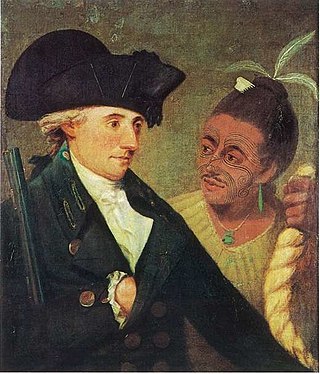
Captain Charles Clerke was an officer in the Royal Navy who sailed on four voyages of exploration, three with Captain James Cook. When Cook was killed during his 3rd expedition to the Pacific, Clerke took command but died later in the voyage from tuberculosis.

Portsmouth Naval Prison is a former U.S. Navy and Marine Corps prison on the grounds of the Portsmouth Naval Shipyard (PNS) in Kittery, Maine. The building has the appearance of a castle. The reinforced concrete naval prison was occupied from 1908 until 1974.

HMS Jersey was a 60-gun fourth rate ship of the line of the Royal Navy, built to the 1733 proposals of the 1719 Establishment of dimensions at Plymouth Dockyard, and launched on 14 June 1736. She saw action in the War of Jenkins' Ear and the Seven Years' War, before being converted to a hospital ship in 1771. In 1780 she was converted again, this time to a prison ship, and was used by the British during the American Revolutionary War.

HMS Jumna was a Euphrates-class troopship launched at Palmers Shipbuilding and Iron Company at Hebburn on 24 September 1866. She was the third vessel of the Royal Navy to carry the name.

Ambroise Louis Garneray was a French corsair, painter and writer. He served under Robert Surcouf and Jean-Marie Dutertre, and was held as prisoner-of-war by the British for eight years after being captured before being repatriated at the conclusion of the Napoleonic Wars, continuing his career as a painter until his death in 1857.

HMS Medway was a 74-gun third rate ship of the line of the Royal Navy, launched on 19 November 1812 at Northfleet.
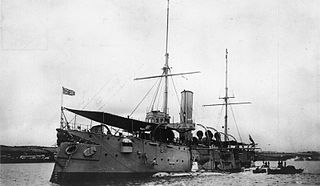
HMS Thames was a Mersey-class protected cruiser built for the Royal Navy (RN) in the 1880s. The ship was placed in reserve upon her completion in 1888 and was converted into a submarine depot ship in 1903. She was sold out of the navy in 1920 and was purchased by a South African businessman to serve as a training ship for naval cadets under the name SATS General Botha. The ship arrived in South Africa in 1921 and began training her first class of cadets in Simon's Town the following year. General Botha continued to train cadets for the first several years of World War II, but the RN took over the ship in 1942 for use as an accommodation ship under her original name. She was scuttled by gunfire in 1947 and is now a diveable wreck.
HMS Peterel was a river gunboat built by Yarrow Shipbuilders at Scotstoun and she was the sixth ship of the Royal Navy to carry the name. Her name used an archaic spelling for consistency with previous Royal Navy Ships of the same name, in contrast to the modern accepted spelling petrel.

HMS Hindostan was a 50-gun two-decker fourth rate of the Royal Navy. She was originally a teak-built East Indiaman named Admiral Rainier launched at Calcutta in 1799 that the Royal Navy brought into service in May 1804. Before the Royal Navy purchased her, Admiral Rainier made two trips to England for the British East India Company (EIC), as an "extra ship", i.e., under charter. Perhaps her best known voyage was her trip to Australia in 1809 when she and Dromedary brought Governor Lachlan Macquarie to replace Governor William Bligh after the Rum Rebellion. In later years she became a store ship, and in 1819 was renamed Dolphin. She was hulked in 1824 to serve as a prison ship, and renamed Justitia in 1831. She was finally sold in 1855.

HMS Investigator was the mercantile Fram, launched in 1795, which the Royal Navy purchased in 1798 and renamed HMS Xenophon, and then in 1801 converted to a survey ship under the name HMS Investigator. In 1802, under the command of Matthew Flinders, she was the first ship to circumnavigate Australia. The Navy sold her in 1810 and she returned to mercantile service under the name Xenophon. She was probably broken up c.1872.
HMS Howe was originally the teak-built Indian mercantile vessel Kaikusroo that Admiral Edward Pellew bought in 1805 to serve as a 40-gun frigate. In 1806 the Admiralty fitted her out as a 24-gun storeship and renamed her HMS Dromedary. She made numerous trips, including one notable one to Australia when she brought out Lachlan Macquarie and his family to replace William Bligh as governor of New South Wales. Later, she became a prison hulk in Bermuda. Her most recent contribution, however, is as the source of a rich archaeological site.

HMS Princess was a 70-gun third rate ship of the line of the Royal Navy. She had served for ten years as the Princesa for the Spanish Navy, until her capture off Cape Finisterre in 1740 during the War of the Austrian Succession.
Phoenix was a three-decker merchant ship built on the Thames in 1798. On a voyage in 1824 on which she first transported convicts to Van Diemen's Land she was damaged on the Sow and Pigs Reef inside Port Jackson Heads, New South Wales, Australia. She was then condemned and turned into a prison hulk. She was broken up in 1837.
